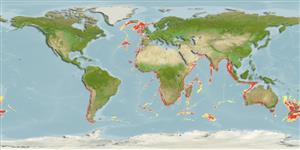Classification / Names
Common names from other countries
Issue
As Centroselachus crepidater in Ref. 58085:113; please send taxonomic reference(s) to confirm genus placement.
Main reference
Size / Weight / Age
Max length : 130 cm TL male/unsexed; (Ref. 6577); max. reported age: 54 years (Ref. 57506)
Length at first maturity
Lm 75.4, range 82 - ? cm
Environment
Marine; bathydemersal; depth range 230 - 1500 m (Ref. 26346)
Climate / Range
Deep-water, preferred 23°C (Ref. 107945); 64°N - 57°S, 77°W - 159°W
Distribution
Eastern Atlantic: Iceland, Faeroe Islands along Atlantic slope to Portugal, Senegal, Madeira, Gabon to Democratic Republic of the Congo, Namibia. Indian Ocean: Aldabra and the Travancore coast of India. Western Pacific: New South Wales, Australia and New Zealand. Southeast Pacific: northern Chile.
Countries | FAO areas | Ecosystems | Occurrences | Introductions
Short description
Dorsal
spines
(total): 2;
Dorsal
soft rays
(total): 0;
Anal
spines: 0;
Anal
soft rays: 0. Black or blackish brown in color, dorsal fins with very small fin spines, very long snout, greatly elongated labial furrows that nearly encircle mouth, lanceolate upper teeth and bladelike lower teeth with moderately long, oblique cusps, fairly slender body that does not taper abruptly from pectoral region, moderately large lateral trunk denticles with partly smooth, oval, cuspidate crowns in adults and subadults (Ref. 247).
IUCN Red List Status (Ref. 115185)
Threat to humans
Poisonous to eat (Ref. 6871)
Human uses
Fisheries: minor commercial
More information
ReferencesAquacultureAquaculture profileStrainsGeneticsAllele frequenciesHeritabilityDiseasesProcessingMass conversion
Tools
Special reports
Download XML
Internet sources
Estimates of some properties based on models
Phylogenetic diversity index
PD50 = 0.5313 many relatives (e.g. carps) 0.5 - 2.0 few relatives (e.g. lungfishes)
Trophic Level
4.2 ±0.4 se; Based on diet studies.
Resilience
Very Low, minimum population doubling time more than 14 years (Fec=4-8, tmax=54, tm=9-15)
Vulnerability
Very high vulnerability (78 of 100)
Price category
